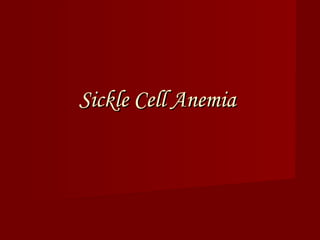
Sickle cell anemia
- 2. Sickle Cell Anemia Sickle cell anemia is a disease passed down through families in which red blood cells form an abnormal crescent shape. (Red blood cells are normally shaped like a disc.)
- 3. Causes, incidence, and risk factors Hemoglobin is a protein inside red blood cells that carries oxygen. Sickle cell anemia is caused by an abnormal type of hemoglobin called hemoglobin S. Hemoglobin S distorts the shape of red blood cells, especially when exposed to low oxygen levels. The distorted red blood cells are shaped like crescents or sickles. These fragile, sickle-shaped cells deliver less oxygen to the body's tissues. They can also clog more easily in small blood vessels, and break into pieces that disrupt healthy blood flow. Sickle cell anemia is inherited from both parents. Sickle cell disease is much more common in people of African and Mediterranean descent. It is also seen in people from South and Central America, the Caribbean, and the Middle East. Someone who inherits the hemoglobin S gene from one parent and normal hemoglobin (A) from the other parent will have sickle cell trait. People with sickle cell trait do not have the symptoms of true sickle cell anemia.
- 4. Symptoms Symptoms usually don't occur until after age 4 months. Almost all patients with sickle cell anemia have painful episodes (crises), which can last from hours to days. These crises can affect the bones of the back, the long bones, and the chest. Some patients have one episode every few years. Others have many episodes per year. The crises can be severe enough to require a hospital stay. Common symptoms include: – Attacks of abdominal pain – Bone pain – Breathlessness – Delayed growth and puberty – Fatigue – Fever – Paleness – Rapid heart rate – Ulcers on the lower legs (in adolescents and adults) – Yellowing of the eyes and skin (jaundice) Other symptoms include: – Chest pain – Excessive thirst – Frequent urination – Painful and prolonged erection (priapism - occurs in 10 - 40% of men with the disease) – Poor eyesight/blindness – Strokes – Skin ulcers
- 5. Treatment Patients with sickle cell disease need ongoing treatment, even when they are not having a painful crisis. They should take supplements of folic acid (essential for producing red blood cells) because red blood cells are turned over so quickly. The purpose of treatment is to manage and control symptoms, and to limit the frequency of crises. During a sickle cell crisis, you may need certain treatments. Painful episodes are treated with pain medicines and by drinking plenty of fluids. It is important to treat the pain. Non- narcotic medications may be effective, but some patients will need large doses of narcotics. Hydroxyurea (Hydrea) is a drug some patients use to reduce the number of pain episodes (including chest pain and difficulty breathing). It does not work for everyone. Antibiotics and vaccines are given to prevent bacterial infections, which are common in children with sickle cell disease. Blood transfusions are used to treat a sickle cell crisis. They may also be used on a regular basis to help prevent strokes. Other treatments for complications may include: – Dialysis or kidney transplant for kidney disease – Drug rehabilitation and counseling for psychological complications – Gallbladder removal (if you have gallstone disease) – Hip replacement for avascular necrosis of the hip – Irrigation or surgery for persistent, painful erections (priapism) – Surgery for eye problems – Wound care, zinc oxide, or surgery for leg ulcers Bone marrow or stem cell transplants can cure sickle cell anemia. However, transplants have many risks, including infection, rejection, and graft-vs-host disease. Therefore, they are currently not an option for most patients. Also, sickle cell anemia patients are often
- 6. Complications Acute chest syndrome Anemia Blindness/vision impairment Brain and nervous system (neurologic) symptoms and stroke Death Disease of many body systems (kidney, liver, lung) Drug (narcotic) abuse Erectile dysfunction (as a result of priapism) Gallstones Hemolytic crisis Infection, including pneumonia, gallbladder inflammation (cholecystitis), bone infection (osteomyelitis), and urinary tract infection Joint destruction Leg sores (ulcers) Loss of function in the spleen Parvovirus B19 infection, leading to low red blood cell production (aplastic crisis) Splenic sequestration syndrome Tissue death in the kidney
- 7. Preventions Sickle cell anemia can only occur when two people who carry sickle cell trait have a child together. Genetic counseling is recommended for all carriers of sickle cell trait. About 1 in 12 African Americans has sickle cell trait. It is possible to diagnose sickle cell anemia during pregnancy. You can prevent sickling of red blood cells by: – Getting enough fluids – Getting enough oxygen – Quickly treating infections Have physical exams every 3 - 6 months to ensure that you are getting enough nutrition and activity, and that you are receiving the proper vaccinations. Regular eye exams are also recommended. PREVENTING INFECTIONS – People with sickle cell anemia need to keep their immunizations up to date, including Haemophilus influenza, pneumococcal, meningococcal, hepatitis B, and influenza – Some patients may receive antibiotics to prevent infections. PREVENTING CRISES Parents should encourage children with sickle cell anemia to lead normal lives. To reduce sickle cell crises, take the following precautions: – To prevent oxygen loss, avoid: Demanding physical activity (especially if the spleen is enlarged) Emotional stress Environments with low oxygen (high altitudes, nonpressurized airplane flights) Smoking Known sources of infection – To make sure you're getting enough fluids: Avoid too much exposure to the sun Have fluids on hand, both at home and away Recognize signs of dehydration – To avoid infection: Consider having the child wear a Medic Alert bracelet Have the child vaccinated as recommended by the health care provider Share the above information with teachers and other caretakers, when necessary Be aware of the effects that chronic, life-threatening illnesses can have on siblings, marriages, parents, and the child.
